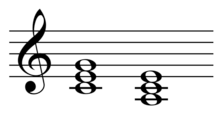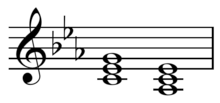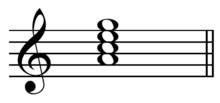Submediant









In music, the submediant is the sixth scale degree of the diatonic scale, the 'lower mediant' halfway between the tonic and the subdominant or 'lower dominant'.[4] It is also the third factor of the subdominant (IV) triad. It is occasionally called superdominant[5] being above the dominant. It is sung as la in solfege.
In music theory, the submediant chord is symbolized by the Roman numeral VI if it is major or vi if it is minor.[6]
For example, in the C major scale (white keys on a piano, starting on C), the submediant is the note A; and the submediant chord is A-minor consisting of the notes A, C, and E. Therefore, Am is the vi chord in the C major scale. Since the submediant is minor it may provide contrast with major chords, frequently in a sequence of descending thirds (I, vi, IV, ii | V in root position or first inversion).[1] Further, in the A natural minor scale (same white keys, now starting on A), the submediant is the note F; and the submediant chord is F (or F-major) consisting of the notes F, A, and C. Therefore, F is the VI chord in the A (natural) minor scale.

The submediant is also in the same relationship to the supertonic as the supertonic is to the dominant, resulting in a descending series of perfect fifths known as an extended dominant relationship.[1] See: predominant and circle progression.
The submediant is usually preceded by the mediant, tonic, or dominant and succeeded by supertonic, dominant, or subdominant.[8] The submediant function is easily explained in reference to jazz music, where it is used in the "ice cream change" or "Blues for Alice" progression, which moves from the tonic through the submediant on the way to the ubiquitous ii-V-I Jazz sequence (part of the cycle of fifths). The progression's consistency is amplified by the submediant's fifth-relationship above the supertonic. This submediant role—in which it essentially extends from the tonic as a way of passing to a subdominant (IV) or supertonic (II) harmony, is as common in popular and classical music as it is in jazz, or any other musical language related to Western European tonality.
Both vi6 and iii6 are weak and rarely independent, being either linear chords or with the third or sixth scale degree as a nonharmonic tone.[9]
"Submediant" also refers to a relationship of musical keys. For example, relative to the key of C major, the key of A major (or A minor) is the submediant. Modulation (change of key) to the submediant is relatively rare, compared with, for instance, modulation to the dominant, and gives a feeling of relaxation. Susan McClary says that modulation to the lowered submediant (in C: A♭) represents a dream-like state of escape.
In German theory derived from Hugo Riemann the submediant in major is considered the tonic parallel (US relative), Tp, and the minor the subdominant parallel, sP.
Chromatic submediants are, like all chromatic mediants, chords whose roots are related by a major third or minor third, contain one common tone, and share the same quality, i.e. major or minor. They may be altered chords.

In rock and popular music, VI in minor often uses the chromatically lowered fifth scale degree as its seventh, VI7, for example as in Bob Marley's clearly minor mode "I Shot The Sheriff".[10]
See also
Sources
- 1 2 3 4 5 William G Andrews and Molly Sclater (2000). Materials of Western Music Part 1, p.226. ISBN 1-55122-034-2.
- ↑ Forte, Allen (1979). Tonal Harmony in Concept & Practice, p.95. Third edition. ISBN 0030207568.
- ↑ MacDowell, Edward A. (2008 edition). The Music-Lover's Handbook, p.167. ISBN 1-4437-8087-1.
- ↑ Benward & Saker (2003). Music: In Theory and Practice, Vol. I, p.33. Seventh Edition. ISBN 978-0-07-294262-0.
- ↑ Ebenezer PROUT, Harmony: its theory and practice, 09/09/2010
- ↑ Bartlette, Christopher, and Steven G. Laitz (2010). Graduate Review of Tonal Theory. New York: Oxford University Press, pg 102-106. ISBN 978-0-19-537698-2
- ↑ Chadwick, G.H. (2009). Harmony - A Course Of Study, p.36. ISBN 1-4446-4428-9.
- ↑ Benjamin, Horvit, and Nelson (2007). Techniques and Materials of Music: From the Common Practice Period Through the Twentieth Century, p.100. ISBN 0-495-18977-4.
- ↑ Benjamin, et al. (2007), p.101.
- ↑ Stephenson, Ken (2002). What to Listen for in Rock: A Stylistic Analysis, p.89. ISBN 978-0-300-09239-4.
